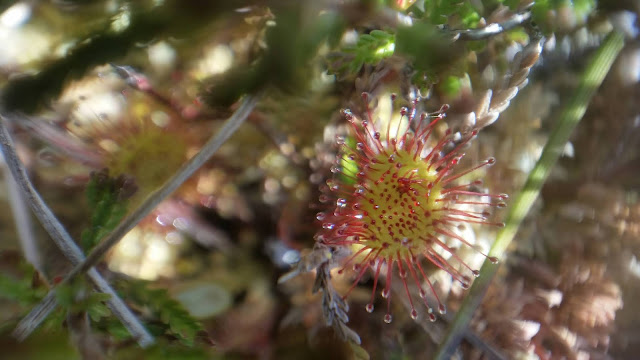I have mentioned before that I do annual surveys for the National Plant Monitoring Scheme so I thought it was time to get on with this year's surveys. Three of the squares that I monitor are on Craggan, two in boggy areas and one in the birch wood. The bog cotton was out and made a lovely display.
There weren't many wildflowers but there were other plants that are typical of moorland. One is a grass called Mat-grass (Nardus stricta) which looks like a clump of black needles.
 |
| A clump of Mat-grass |
It is a perennial grass and comes back every year. Last year's growth is the white strands at the base. Once the grass heads open they no longer look like needles but remind me of fish bones.
Another "non-flower" that you find in wet places is Black Sedge (Carex nigra). It actually does have a flower but not with petals that you get on most wildflowers. Instead there are two sorts of spikes, the male ones at the top that produce pollen and the female ones lower down that produce the seeds.
 |
| 2 stalks of Black Sedge |
The next site I monitor was already occupied by a red deer, probably a 1 year old stag looking at the antlers. It was not keen to move but lumbered off when I got closer.
The third site was not particularly interesting, but there was an interesting rock outcrop nearby that I took a look at as I had checked it out a few years ago and knew it had an interesting lichen called Peltigera brittanica. It looks like green speckled leaves, and is not very common.
 |
| The rock outcrop |
 |
| Peltigera brittanica |
There were a couple more interesting lichens on the rock that resemble corals - they are both Sphaerophorus species and to distinguish between them, you have to look at the thickness of the "stalks" when they branch. If they stay the same width when they branch, it is S. fragilis, but if they get thinner as they branch, it is S. globosus.
 |
| Sphaerophorus globosus (on left) and Sphaerophorus fragilis on right |
Finally, a wildflower! This is Bog Stitchwort (Stellaria alsine) which I found on the way back. It is tiny and, as you might expect, grows in boggy places.


















